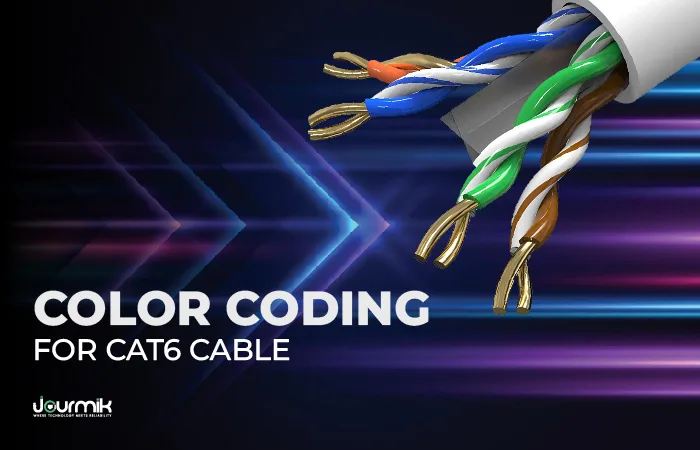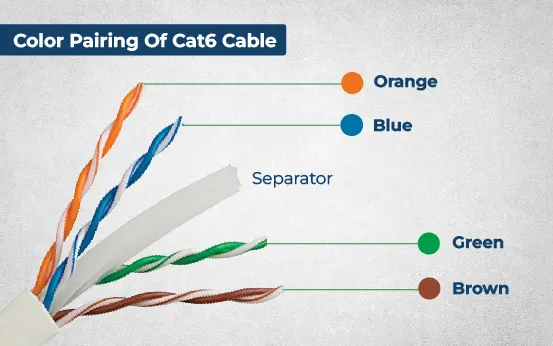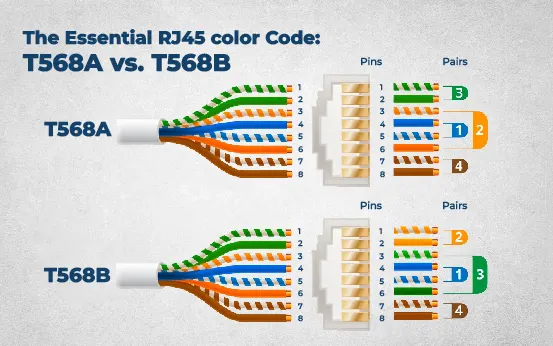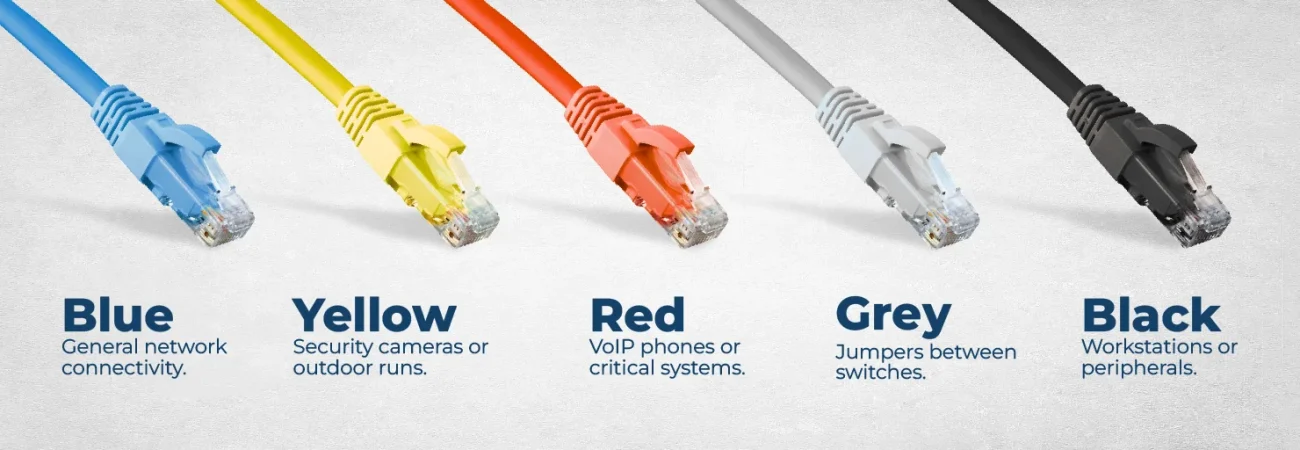Color Coding for Cat6 Cable

Have you ever looked at a bunch of Ethernet cables and thought about their colorful mess? Well, then, you’re not alone. In today’s high-speed digital world, Cat6 cables are the backbone of reliable network connectivity. But without understanding their color coding, you’re essentially navigating a maze blindfolded.
Did you know that a simple miswiring can lead to frustrating network outages and data loss? That’s where the magic of color coding comes in. It ensures seamless data transmission and simplifies network management. Imagine having a clear, organized network where troubleshooting is a breeze.
Read on to find out how mastering Cat6 color coding can save you time and headaches and ensure your network runs smoothly.
Table of Contents
What is Cat6 cable
In simple, Cat6 cables, or Category 6 cables, are twisted pair cables. They are used for Ethernet and other network setups. They enable data transfer speeds of up to 10 gigabits per second. This speed is crucial for today’s high-bandwidth applications.
Unlike their predecessors, like Cat5e, Cat6 cables offer improved performance and reduced crosstalk. This means more reliable data transmission, especially over longer distances. Knowing the specs and standards of Cat6 cables is key to a strong, efficient network.
Inside the Cable: The Four Twisted Pairs
Open a Cat6 cable, and you’ll find eight wires grouped into four twisted pairs. Each pair has a solid color wire (e.g., orange) and a white wire with a matching stripe (e.g., white/orange). These twists aren’t random. They cut down on electromagnetic interference. This way, your data flows smoothly. The colors, orange, green, blue, and brown, follow a strict code to keep connections consistent.

The Role of RJ45 Connectors
The RJ45 connector is the plug that snaps your Cat6 cable into devices like routers or switches. Inside, eight wires line up with eight pins. The color coding shows their order. Get it wrong, and your network might stutter or fail entirely. That’s where standards like T568A and T568B come in, making sure every pin does its job.

The Essential RJ45 color Code: T568A vs. T568B
The RJ45 connector is the standard for Ethernet cables. It uses a specific color code for proper wiring.
There are two main color codes: T568A and T568B.
- T568A: This standard arranges the wires in the following order: green-white, green, orange-white, blue, blue-white, orange, brown-white, and brown. It’s commonly used in residential and some commercial installations.
- T568B: This standard arranges the wires differently: orange-white, orange, green-white, blue, blue-white, green, brown-white, and brown. It’s more prevalent in commercial and government installations.

Knowing these codes is essential for creating consistent and reliable network connections.
Side-by-side comparison of T568A and T568B color codes for RJ45 connectors.
| Pin | T568A | T568B |
| 1 | White/Green | White/Orange |
| 2 | Green | Orange |
| 3 | White/Orange | White/Green |
| 4 | Blue | Blue |
| 5 | White/Blue | White/Blue |
| 6 | Orange | Green |
| 7 | White/Brown | White/Brown |
| 8 | Brown | Brown |
Step-by-Step Guide to Wiring a Cat6 Cable
Tools You’ll Need
Before you dive in, gather these essentials:
- Cable stripper: To remove the outer jacket cleanly.
- RJ45 crimping tool: This is used for securing the connector.
- Cat6 cable: Ensure it’s pure copper, not copper-clad aluminum.
- RJ45 connectors: Match your cable type.
- Cable tester: To verify your work.
Wiring Process with color Coding
Here’s how to wire a Cat6 cable using T568B (adapt for T568A if preferred):
- Strip the jacket: Cut 1-2 inches off the cable’s end, exposing the twisted pairs.
- Untwist and arrange: Separate the pairs and align them in T568B order: white/orange, orange, white/green, blue, white/blue, green, white/brown, brown.
- Trim the wires: Cut them to an even ½ inch length, keeping twists intact as long as possible.
- Insert into RJ45: Slide the wires into the connector, ensuring each reaches the end.
- Crimp: Use the crimping tool to lock the connector in place.
- Repeat: Do the other end, matching the same standard.
Details about how can cat6 be spliced is explained here in the blog
Common Uses of Cat6 color Coding
Straight-Through Cables
Most Cat6 cables are straight-through, connecting devices like a PC to a switch. Both ends use the same standard (e.g., T568B), with the color code ensuring transmit and receive pins align. The orange and green pairs manage data. The blue and brown ones are usually not used in older, slower systems. Still, all four pairs support 10 Gbps.
Crossover Cables
For direct device-to-device links (e.g., two PCs), crossover cables swap the transmit and receive pairs. One end follows T568B, the other T568A, flipping orange and green pairs. Devices with auto-MDIX can adjust. But knowing the color codes for Cat6 cables helps you with older equipment.
Power over Ethernet (PoE)
PoE delivers power and data over Cat6, powering devices like IP cameras. The blue and brown pairs typically carry power, while orange and green handle data. Using the right color coding helps deliver power efficiently. This prevents damage to your equipment, which is crucial for long cable runs.
Troubleshooting color Coding Mistakes
Signs of Incorrect Wiring
Messed up your RJ45 color code Cat6? Watch for these red flags:
- No connection: Lights blink, but no internet.
- Slow speeds: Dropping below expected performance.
- Interference: Crackling on VoIP calls or packet loss.
How to Test Your Cable
Grab a cable tester, it’s your best friend. Plug both ends in, and it’ll light up to show if the pins match the standard. If not, double-check your color order against T568B (or A). A visual inspection of the RJ45 connector can also reveal crossed or loose wires.
Beyond the Wires: Jacket color Coding
The color-coding inside a Cat6 cable affects performance, but the outer jacket does not. That’s purely organizational. It doesn’t change how the cable works, only how you manage it. Still, a smart color system can save you headaches in a tangled mess of cables.
Popular Jacket color Conventions
Here’s what pros often use:
- Blue: General network connectivity.
- Yellow: Security cameras or outdoor runs.
- Red: VoIP phones or critical systems.
- Grey: Jumpers between switches.
- Black: Workstations or peripherals.

Tips for Organizing Your Network
Create your own color combination for Cat6 cables. For example, use green for PoE devices and white for legacy systems. Label ends with tape or a marker, and keep a cheat sheet handy. It’s less about the standard and more about what works for you.
Conclusion
Mastering the color coding for Cat6 cables is simple. It requires precision and consistency. Whether you’re crimping a straight-through cable with T568B or troubleshooting a crossover setup, the right RJ45 color code Cat6 keeps your network humming.
You’ve learned the standards, the wiring process, and even how to organize with jacket colors. Now, it’s time to put it into action.
Ready to upgrade your setup?
Check out our top-notch Cat6 cables and tools at Jourmik. A solid network begins with the right base.
Got questions? Drop them below, and let’s keep the conversation going!
FAQs
What is the color code for an Ethernet cable?
The standard color code for Ethernet cables follows the TIA/EIA-568-B, specifically the T568B configuration. It uses four twisted pairs with colors: orange-white, orange, green-white, green, blue-white, blue, brown-white, and brown.
What is the color sequence in an Ethernet cable?
For T568B, the sequence is: 1. Orange-white, 2. Orange, 3. Green-white, 4. Blue, 5. Blue-white, 6. Green, 7. Brown-white, 8. Brown. This order aligns the twisted pairs correctly for data transmission in Ethernet cables.
What color should my Ethernet cable be?
The outer jacket color of an Ethernet cable doesn’t affect performance; it’s typically gray, blue, or black. Choose based on preference or organization (e.g., blue for data, red for emergencies).
How to arrange color in an Ethernet cable?
Strip the cable, untwist the pairs, and align them in the T568B order: Orange-white, Orange, Green-white, Blue, Blue-white, Green, Brown-white, Brown. Insert into an RJ45 connector and crimp securely for proper connectivity.
What color Ethernet cable is the fastest?
Speed isn’t determined by the cable’s outer color but by its category (e.g., Cat5e, Cat6, Cat7) and internal wiring quality.
Is Ethernet and RJ45 the same?
No, Ethernet is a networking technology, while RJ45 is the connector type commonly used for Ethernet cables. RJ45 plugs carry Ethernet signals, but the terms refer to different aspects of networking.
How to remember Ethernet color code?
Use a mnemonic for T568B: “Orange you glad I’m blue-green, brown?” Pair it: Orange-white/Orange, Green-white/Blue, Blue-white/Green, Brown-white/Brown. Practice stripping and arranging to reinforce the sequence.
